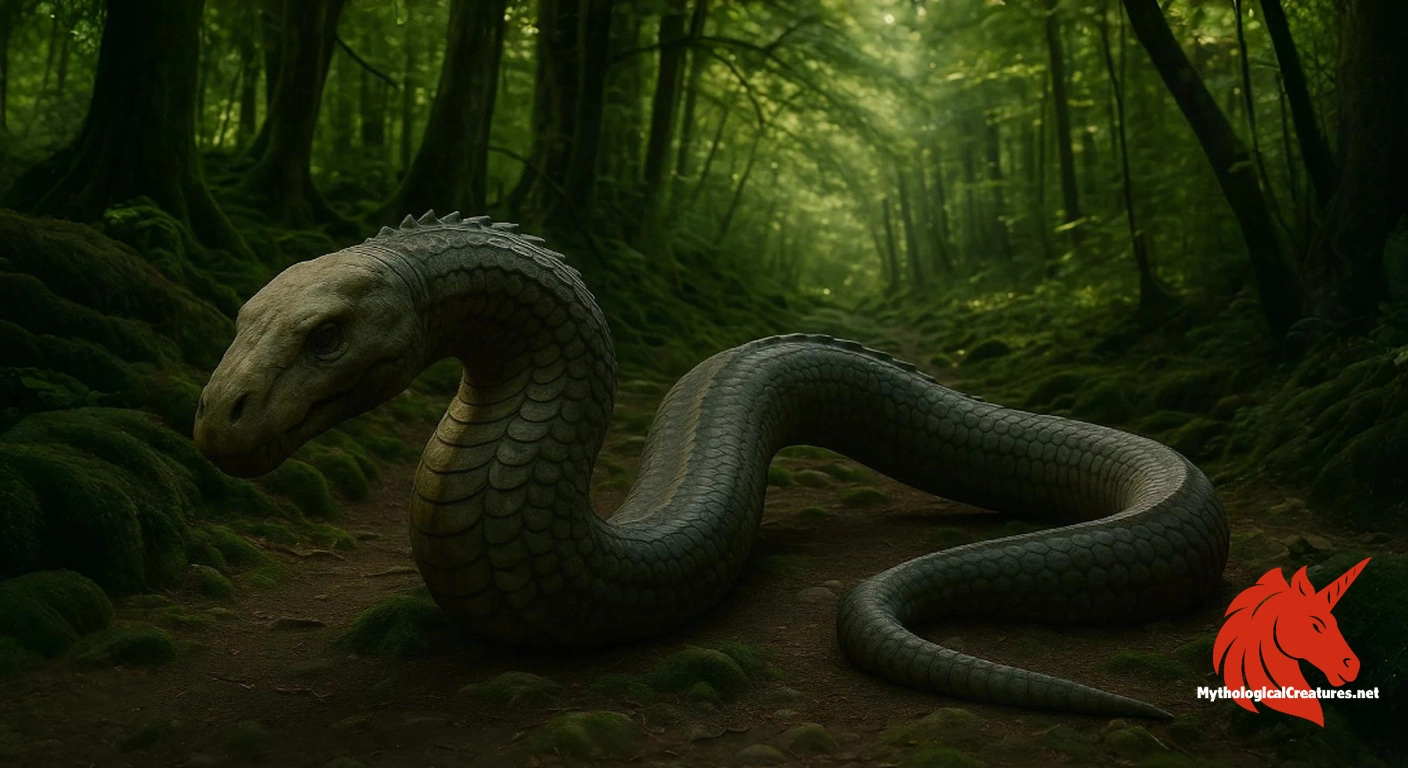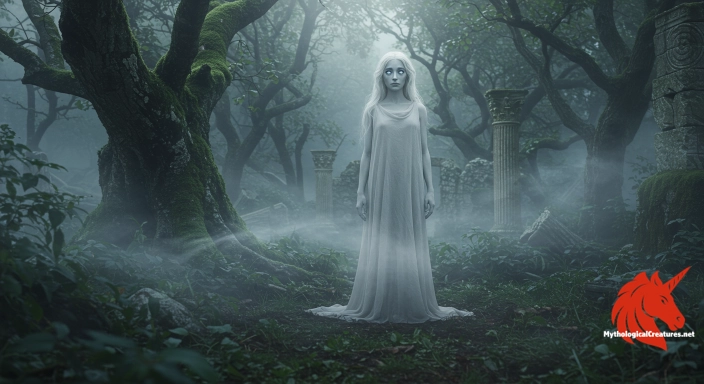Lindworm: The lindworm is a mythological serpent-like creature from Northern, Western and Central European folklore.

Lindworm
Lindworm - Symbolises the dual nature of fortune and danger; its presence is believed to both enrich its territory and pose a lethal threat to humans
Origins & First Encounters
The lindworm is one of the most enigmatic creatures, its sinuous form and multifaceted nature captured in legends spanning Northern, Western, and Central Europe. It emerged from deep, shadowed forests where the boundaries between nature and myth blur in mysterious ways. Tales depict this beast as a giant, serpentine monster that both terrifies and fascinates, its origins intertwined with ancient rites and the lore of untamed wilderness. The creature’s legend is steeped in symbolism, often representing themes of transformation, fortune, and the duality of good and evil. Early narratives imbued the lindworm with the power to magnify what it possessed, a concept that resonated with communities fascinated by the interplay of growth and decay. Its myth also includes transformations where a cursed prince might be condemned to live as this formidable beast, adding layers of human emotion to its character. The rich cultural context of medieval Europe, with its intricate web of superstitions and moral allegories, provided a perfect backdrop for the creature’s many interpretations. Over time, the lindworm has served as a metaphor for both nature’s unpredictable bounty and its inherent danger. Even today, its enduring myth continues to capture the imagination, standing as a testament to the complex intermingling of history, culture, and the natural world.
Source Texts & Tale Variants
Ancient manuscripts and regional folklore have long preserved the diverse narratives of the lindworm, offering a window into a multifaceted myth. Written accounts from medieval Europe frequently detail its appearance as both a benevolent guardian and a fearsome man-eater of the wild. Various story variants introduce a dual nature where one form is associated with luck and the transformative magic of curses, while another is remembered for relentless aggression toward humans. Some chronicles recount the beast as a cursed prince, echoing transformation tales that bridge the gap between human frailty and monstrous power. Folktales across different regions have enriched its lore, each artistic rendition contributing subtle differences to its mythic anatomy and role in the natural order. There are vivid depictions in local ballads, illustrated codices, and even early public monuments that have celebrated or warned against its presence. Certain accounts highlight its strange ability to multiply the riches around it, a belief that has spanned generations. The intertwining of the lindworm myth with broader folklore, including motifs of treasure and metamorphosis, demonstrates a wide oral and written tradition. These layered sources continue to inspire modern storytellers, preserving a narrative that is as dynamic as it is ancient.
Form & Powers
The lindworm is typically portrayed as a majestic yet menacing serpent, its elongated body adorned with a lattice of intricate scales that catch the light in mysterious flashes. Its head is often described as carrying hints of a once-human visage, combining both regal features and the raw power of a predatory beast. The creature’s body, long enough to evoke awe and terror, is said to undulate gracefully through dark forest depths, sometimes lacking prominent limbs but retaining vestigial hints of ancestral form. Many descriptions focus on its keen, penetrating eyes and a powerful jaw capable of consuming both prey and fate itself. There is a striking detail in some legends where the lindworm is capable of swallowing its own tail, creating a continuous loop that symbolises eternal cyclicality. Artistic renditions have varied, with some illustrating a set of subtle, wing-like protrusions or horn-like features that enhance its spectral allure. Shadows and light play across its form in the tales—as if the creature shifts in size and strength with each passing season. The undulating motion of its body, coupled with a texture that seems both ancient and otherworldly, captures the imagination of those who encounter its image. Every physical detail, whether rendered in stone or scribed in a manuscript, builds a portrait of a creature that is as enigmatic as it is timeless.
Regional Faces
The depiction of the lindworm differs markedly across various regions, each local tradition colouring its appearance and character with unique cultural nuances. In Northern Europe, the creature is often portrayed as a sleek, enigmatic serpent that inhabits the secluded expanses of untamed woodlands. Central European legends tend to emphasise its dual nature, portraying it as a guardian of hidden treasures and a harbinger of both fortune and doom. Western European narratives frequently focus on its terrifying aspect, where the beast is depicted as a relentless man-eater, a living test of human courage. Some regions have embraced a more sympathetic version, where the lindworm is seen as a cursed being with the latent capacity for redemption. Local festivals and folklore assemblies have incorporated the creature into artistic expression, blending its myth with regional history and landscape. Variations in its description—from subtle changes in scale texture to differences in size and form—mirror the diverse communities that have claimed it as their own. Even the manner in which the creature is confronted or revered in local legends reflects specific societal ideals about nature, fate, and transformation. Collectively, these regional adaptations reveal a flexible myth that continually absorbs and reflects the cultural identities of its narrators.
Cultural Parallels
The lindworm holds a distinctive place among mythological creatures, resonating with similar figures found in diverse cultural landscapes. Its serpentine nature and association with treasure accumulation evoke comparisons with the classic dragons of Eastern and Western traditions. Like many legendary reptiles, it embodies the paradox of creation and destruction, a theme that finds echoes in the myth of the ouroboros. The narrative of a cursed prince turned beast invites parallels with transformation tales seen in European metamorphosis myths such as the Frog Prince or the more modern Beauty and the Beast. Its peculiar ability to chase its own tail relates it to the imagery of the hoop snake, further bridging myth with natural allegory. Across cultures, dragons and serpent-like beings are often endowed with the mystique of both benevolence and malevolence, a duality that the lindworm encapsulates beautifully. Comparative analysis reveals that while many traditions focus solely on the terror of a fire-breathing behemoth, the lindworm’s legend balances menace with a nuanced potential for renewal. Such parallels illustrate a shared human fascination with creatures that defy binary categorisation, embodying both the light and shadow of existence. In this way, the lindworm stands as a symbolic nexus, weaving together disparate mythic strands from across the tapestry of world folklore.
Legacy & Modern Evolution
Over the centuries, the lindworm has evolved from a shadowy denizen of mythic forests into a celebrated icon in art, literature, and modern popular culture. Its early depictions carved indelible images of danger and mystery in the medieval imagination, inspiring both cautionary tales and heroic quests. The 16th-century statue at the Lindwurm Fountain in Klagenfurt, Austria, serves as a tangible reminder of its long-standing cultural impact, even drawing on elements such as the skull of a woolly rhinoceros to evoke ancient natural history. As eras passed, its depiction softened and deepened, merging the ferocity of its animal form with a poignant narrative of cursed transformation and redemption. Contemporary portrayals often explore the lindworm as a symbol of inner conflict, a creature caught between the feral and the human. Modern fantasy genres have embraced its myth, reimagining it in novels, role-playing games, and visual arts as a complex being with layers of tragic beauty. The creature’s legacy is marked by its persistent ability to adapt, reflecting shifting societal concerns and the allure of the unknown. Its enduring myth continues to inspire a reassessment of the relationships between nature, civilisation, and the mysteries that defy explanation. In essence, the lindworm remains a vivid emblem of how ancient myth can transcend time, providing fertile ground for modern reinterpretation and timeless symbolism.
Interesting Fact
The lindworm is not only a creature of myth but also an early example of artists using extinct animal remains, such as a woolly rhinoceros skull, to shape legendary imagery.
Quick Creature Info
Origin:
Associations:
Our Mythic Legendary Rating:

Also Sometimes Known As:
Habitat:
Supernatural Powers:
Physical Attributes:
Abilities:
Behavior:
Lore:
Related Creatures, Tales or Lore
- DDragon
- OOuroboros
- HHoop Snake
References
Discover Another Mythical Legend You May Not Have Heard Of?
Uncover the mysteries of ancient folklore and expand your knowledge of legendary beings from cultures around the world.
Dare to Meet the Achlys....
Mythical Disclaimer: The images and data on this site are derived from various historical and literary sources, but we have found that many myths often have multiple versions and interpretations across references, sometimes contradictory. As a result, these creature depictions are artistic interpretations—imaginative blends of folklore, legend, and a dash of AI guesswork. Because creature descriptions vary widely, our illustrations and accompanying information represent our best effort to honor mythology while bridging creative gaps. Enjoy these interpretations—just remember, we've done our best to respect the stories and validate available data, but in the realm of mythology, details often shift, imagination leads the way, and nothing is ever set in stone!
Curated by the Mythological Creatures Team (rev. May 2025)
